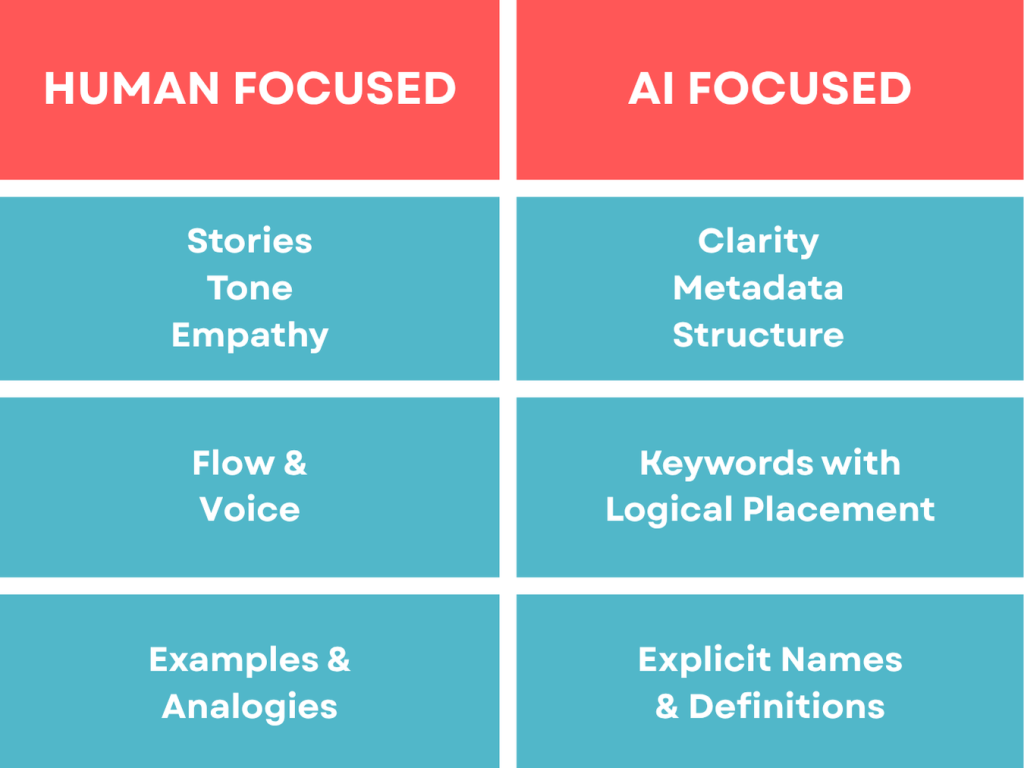How To Write Content Geared Toward AI Search

Best practices for content optimization are ever changing. Gone are the days of keyword stuffing to ensure your content ranks on Google’s algorithms. But you may be wondering exactly how to craft your content in a way that ensures visibility. To understand, you must first understand exactly how current google algorithms sort, filter, and rank your content.
Google relies on AI models to crawl websites in order to determine how and where they should display in search results. These AI models don’t just crawl your website, they summarize, infer, and synthesize your content. Because of this you must write content, not only for your visitors to understand, but also for AI Search to understand. The term AI search might be new to you. Let’s first discuss exactly what AI Search means.
What Does AI Search Mean?
When people think of AI Search, one of two things usually comes to mind:
AI-Powered Search Engines (such as Google’s Search Generative Experience or Bing Copilot): These search engines use AI to generate summaries from multiple sources.
Standalone AI Assistants (such as ChatGPT or Perplexity): These platforms allow users to ask questions directly, and the AI locates or summarizes information from web sources.
In both cases, AI behaves as a semantic filter, interpreting context, relevance, and credibility to determine what content is useful and trustworthy.
In practical terms:
- AI values clarity over cleverness. Language that is clear and concise means AI is more likely to summarize and cite your content.
- AI prefers well structured information with bullet points, subheadings, and clean formatting.
- AI elevates authoritative, original content over filler text and repeated content that is clearly filled with old SEO practices.
If old SEO methods were talking to algorithms, modern AI search is about teaching the algorithms. Your goal should be to show the AI models why your content is trustworthy and relevant.
Write for Meaning, Not Just Keywords
In the old SEO world, keywords meant visibility. But in the AI era semantic relevance is what drives ranking.
AI doesn’t just look for keyword phrases, it processes related ideas as well. For the keyword phrase “web design near me”, AI models will look for similar terms such as:
- Best web development companies near me
- Website design firms near me
- Website development in Austin
- Who to hire for web design in Austin
To align with AI comprehension:
- Use natural language and phrasing that answers questions people might be asking
- Include contextual phrases related to your business, products, or services offered. For example, our content might include phrases like: “how to design a website”, “popular website designs”, “user friendly website design”, or even names of specific web design platforms or website builders we use such as WordPress and Elementor.
- Focus on topic groupings rather than simply loading content with isolated keywords.
For example, instead of attempting to rank using a phrase like “web design” use related clusters such as:
- Create a custom website
- Hiring a wordpress developer to create your website
- Building websites with Elementor
This gives AI models more semantic signals about your business, products and services, making your content more likely to appear in AI-generated summaries.

Embrace Conversational and Contextual Writing
AI models are trained on natural human dialogue. If your content sounds natural and conversational, AI will have an easier time understanding and comprehending it.
What Strategies Can Be Used to Write for AI Search?
- Use question based subheadings (much like what you see in this article).
- Use short, varied sentences. AI models process short, clear sentences better than large blocks of text.
- Include contextual transitions such as:
- In other words
- For Example
- Here’s why that matters
- Avoid words like this or that without clear connected references
AI algorithms follow logical patterns rather than making guesses and inferences. You need to use understandable linguistic clues about what each sentence means in order for AI to comprehend what is being said.
For example, following a thought with a stand alone sentence such as “This is how the information is processed” won’t be as effective as a sentence with more clarity like: “Adding clarifying words to a sentence assists AI in processing what your content means.”
Small edits to add clarity to your content can improve the way both humans and AI comprehend what you are trying to communicate.
Should I Prioritize Structure in My Website’s Content?
AI models thrive on structure. These AI models identify hierarchy, relevance, and emphasis by reading your HTML tags, headings, and semantic patterns. A clear structure isn’t just good UX, it’s how machines learn what’s important and relevant.
Best Practices:
- Use subheadings (H2 and H3) to consistently mark shifts in content.
- Open each section with a summary statement that details what follows.
- Use concise bullet points, numbered lists, or tables when possible.
- Don’t forget to add schema markup to your site to provide structured data for AI models.
When AI models summarize content, they typically pull the clearest, most self-contained sentences. Because of this, include standalone sentences that make sense even when used out of context.
For example:
“AI search prioritizes structured, self-contained statements that convey expertise without needing additional context.”
Sentences that contain concise, clear information are more likely to rank higher with AI search algorithms.
Write for Both Humans and AI
When writing content, think of your audience in two parts:
- Humans who want narratives and emotions
- AI algorithms that want structure and semantics
Balance the Two:

Table chart image comparing AI focused content with human focused content
(Below is a copy of this table for legibility and accessibility purposes.)
| Human Focused | AI Focused |
| Stories, tone, empathy | Clarity, metadata, structure |
| Flow and voice | Keywords with logical placement |
| Examples and analogies | Explicit names and definitions |
An appropriately optimized piece of content will feel conversational but also clearly structured and organized. To achieve a balance between conversational content and well structured content:
- Lead with strong narrative hooks, but include definitions and specific intent early in the content.
- Include proper names (specific product names, company names, places, etc.) to improve recognition.
- Keep paragraphs under 120 words.
- Label quotes and data sources clearly
This results in content that feels dynamic to readers and legible to AI models.
Anticipate Search Prompts
Consider language potential visitors might use to search. A simple strategy: Write down five ways someone might phrase a question related to your business, product, or service, and use those as headers or callouts throughout your content.
Build Authority Through Insightful Content
AI models look for short sections of text with meaningful content. These AI algorithms specifically look for depth of content per 100 words to determine if a content block is expert and worthy of being promoted.
To establish authority:
Use primary source data such as case studies, analytics, and direct quotes.
Include comparative reasoning when possible (here is why our product or service is useful and why we rise above competitors).
Include clear definitions when including terms that aren’t widely recognized.
Add explanatory context when possible.
Include Multiple Content Formats and Contextual Cues
AI doesn’t just read text, it also scans images, tables, and captions.
Enhance your content with:
- Labeled infographics: AI reads alt text and captions
- Tables comparing key information
- Step-by-step visuals for how-to content
- Transcripts of video content
Don’t forget to add textual content to every visual on the site so AI models can crawl the images and videos as well.
Keep Your Content Fresh and Updated
AI models favor content that is frequently updated and has recent timestamps.
To remain relevant:
- Refresh content every 3-6 months
- Add updated statistics or information and include dates in content when applicable
- Republish old content with updated dates and information
AI doesn’t distinguish between new and newly relevant; it simply prefers current content. If your content includes 2025 data while competitors still cite 2022, your content is seen to have higher trust.
The Future of Content Is Semantic, Not Robotic
Writing for AI search isn’t about tricking the algorithms. It’s about becoming machine-readable and human-resonant at the same time.
The best-performing content will:
- Explain, not echo
- Teach, not tease
- Structure, not stuff
- And most of all, connect human needs with AI model comprehension
As AI continues to determine how people find and trust information online, you must write with that in mind. Your intent should be to bridge the gap between what humans expect and what AI requires resulting in content that’s meaningful to humans but easily understood by machines.
Posted in: AI, Blogging, Content Marketing, Digital Marketing, SEO
Comments are closed.
Latest & Greatest
- How to Prepare Your Website Content
- How to Fix Common Website Bugs
- Security Enhancements for Website Checkout
- How To Write Content Geared Toward AI Search
- How to Recover a Broken Website
- Designing for Trust: How to Build Credibility in Your Website
- Why Humans Still Matter: The Irreplaceable Role of Human Insight in Web Design
